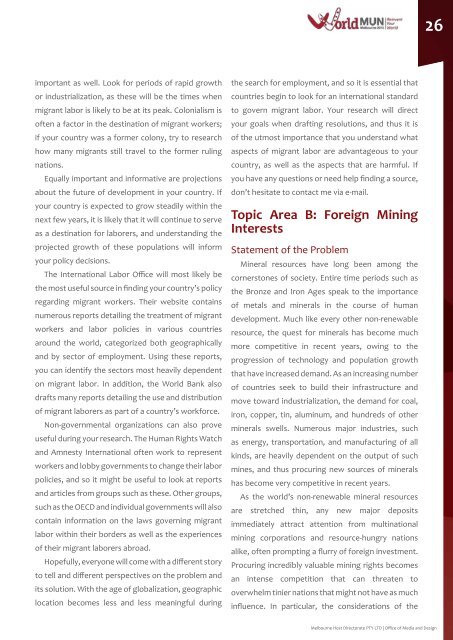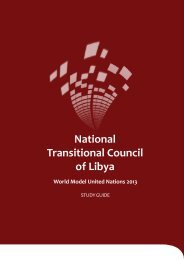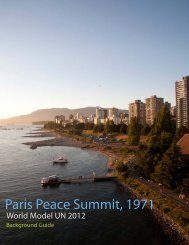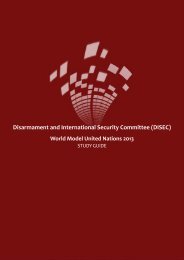SPECPOL - World Model United Nations
SPECPOL - World Model United Nations
SPECPOL - World Model United Nations
Create successful ePaper yourself
Turn your PDF publications into a flip-book with our unique Google optimized e-Paper software.
important as well. Look for periods of rapid growth<br />
or industrialization, as these will be the times when<br />
migrant labor is likely to be at its peak. Colonialism is<br />
often a factor in the destination of migrant workers;<br />
if your country was a former colony, try to research<br />
how many migrants still travel to the former ruling<br />
nations.<br />
Equally important and informative are projections<br />
about the future of development in your country. If<br />
your country is expected to grow steadily within the<br />
next few years, it is likely that it will continue to serve<br />
as a destination for laborers, and understanding the<br />
projected growth of these populations will inform<br />
your policy decisions.<br />
The International Labor Office will most likely be<br />
the most useful source in finding your country’s policy<br />
regarding migrant workers. Their website contains<br />
numerous reports detailing the treatment of migrant<br />
workers and labor policies in various countries<br />
around the world, categorized both geographically<br />
and by sector of employment. Using these reports,<br />
you can identify the sectors most heavily dependent<br />
on migrant labor. In addition, the <strong>World</strong> Bank also<br />
drafts many reports detailing the use and distribution<br />
of migrant laborers as part of a country’s workforce.<br />
Non-governmental organizations can also prove<br />
useful during your research. The Human Rights Watch<br />
and Amnesty International often work to represent<br />
workers and lobby governments to change their labor<br />
policies, and so it might be useful to look at reports<br />
and articles from groups such as these. Other groups,<br />
such as the OECD and individual governments will also<br />
contain information on the laws governing migrant<br />
labor within their borders as well as the experiences<br />
of their migrant laborers abroad.<br />
Hopefully, everyone will come with a different story<br />
to tell and different perspectives on the problem and<br />
its solution. With the age of globalization, geographic<br />
location becomes less and less meaningful during<br />
the search for employment, and so it is essential that<br />
countries begin to look for an international standard<br />
to govern migrant labor. Your research will direct<br />
your goals when drafting resolutions, and thus it is<br />
of the utmost importance that you understand what<br />
aspects of migrant labor are advantageous to your<br />
country, as well as the aspects that are harmful. if<br />
you have any questions or need help finding a source,<br />
don’t hesitate to contact me via e-mail.<br />
Topic Area B: Foreign Mining<br />
Interests<br />
Statement of the Problem<br />
Mineral resources have long been among the<br />
cornerstones of society. entire time periods such as<br />
the Bronze and Iron Ages speak to the importance<br />
of metals and minerals in the course of human<br />
development. Much like every other non-renewable<br />
resource, the quest for minerals has become much<br />
more competitive in recent years, owing to the<br />
progression of technology and population growth<br />
that have increased demand. As an increasing number<br />
of countries seek to build their infrastructure and<br />
move toward industrialization, the demand for coal,<br />
iron, copper, tin, aluminum, and hundreds of other<br />
minerals swells. Numerous major industries, such<br />
as energy, transportation, and manufacturing of all<br />
kinds, are heavily dependent on the output of such<br />
mines, and thus procuring new sources of minerals<br />
has become very competitive in recent years.<br />
As the world’s non-renewable mineral resources<br />
are stretched thin, any new major deposits<br />
immediately attract attention from multinational<br />
mining corporations and resource-hungry nations<br />
alike, often prompting a flurry of foreign investment.<br />
Procuring incredibly valuable mining rights becomes<br />
an intense competition that can threaten to<br />
overwhelm tinier nations that might not have as much<br />
influence. In particular, the considerations of the<br />
26<br />
Melbourne Host Directorate PTY LTD | Office of Media and Design

















